Learning Flock Printing || Special Fabric Printing Method || Fashion Design
We have discussed about the basic methods of fabric printing that are widely applied in Textile sector.
If you missed that session, you may go through the following link: Basic Printing Methods
Today we will discuss about the special Printing method termed as Flock Printing.

Flock Printing
Flock printing is a method of fabric ornamentation where fabric is printed with an adhesive & then finely chopped fibres/flocks are applied by means of dusting-on, air-blast or electrostatic attraction.
Fibres adhere only printed areas & removed from unprinted areas.
It is also called flocking or pile process.
What is Flock
Flock is a material obtained by reducing textile fibres to fragments by cutting, tearing or grinding.
Flock is made from monofilament fiber of viscose, cotton, wool, polyester, acetate etc.
Flocks range 0.9-22 dtex & 0.5-2 mm.
Flocks may be white or colored. The use of flocks gives pile effect.
Basic Principle of Flock Printing
- Application of adhesive: Adhesive is applied to fabric by squeeze, roller, screen or spray method. Synthetic resins is the best adhesive for flock printing. A typical recipe for the application of adhesive-
- Paralac = 50 parts
- White spirit = 34 parts
- China clay = 15 parts
- Lead naptholate (3%) = 0.8 parts
- Cobalt (8%) = 0.3 parts
- Water = x parts
- Total = 1000 parts
Flock application: The flock is applied by means of dusting-on, air-blast or electrostatic attraction from above the material or against the force of gravity, from below the material.
Drying: The drying conditions are dependent on the requirements of particular bonding agent used. Drying is carried out at 700oC for 3-8 mins. Suitable drying unit has steam heated tunnel driers as well as infra-red radiation.
Excess Flock removal: At last excess flocks from unprinted areas are removed by brushing with brush rollers together with a mechanical suction unit.
Methods/Types of Flock Printing
Dusting-on Method: Flocks are applied by shaking, dusting or sprinkling either by hand or through a fine sieve. It produces random flocking.
Air-blast Method: Flocks are applied by a spray gun, lied in a disordered state on fabric. Various sizes guns are available.
Electrostatic Method: Flocks are applied using electrostatic forces. This is the best one method as the flocks are shot into the fabric vertically by using 2 insulated pole-plates. It creates velvet-like appearance that isn’t achieved by other methods.
Advantages of Flock Printing
Create high quality & exclusivity with exceptional tactile & visual experience.
The surface can be entirely or partially flocked.
Flocks are available in various thicknesses, colors & lengths.
Fabric hold a good grip.
Disadvantages of Flock Printing
Very thin line & contours are difficult to execute.
Long flock fibers tend to swell & complicate the production of sharp edge.
Multi-colored motifs are rarely applied due to high workload & cost.
Flock surface may affect the machine processing.
This is Tariqul Islam , I am Lecturer of a recognised Textile Engineering College in Bangladesh. You may follow me to get posts about textiles, fashion and others..
I stumbled upon this thread and couldn't resist chiming in when I saw your post about flock printing. It sounds super interesting and unique, creating designs with that tactile and visual pop. I love how it adds that extra touch of exclusivity to fabrics. Sure, there are some downsides like difficulties with thin lines, but overall, it's such a cool technique. By the way, I recently came across a neat decoupage tutorial that you might find helpful. Just trying to keep this thread useful and updated.